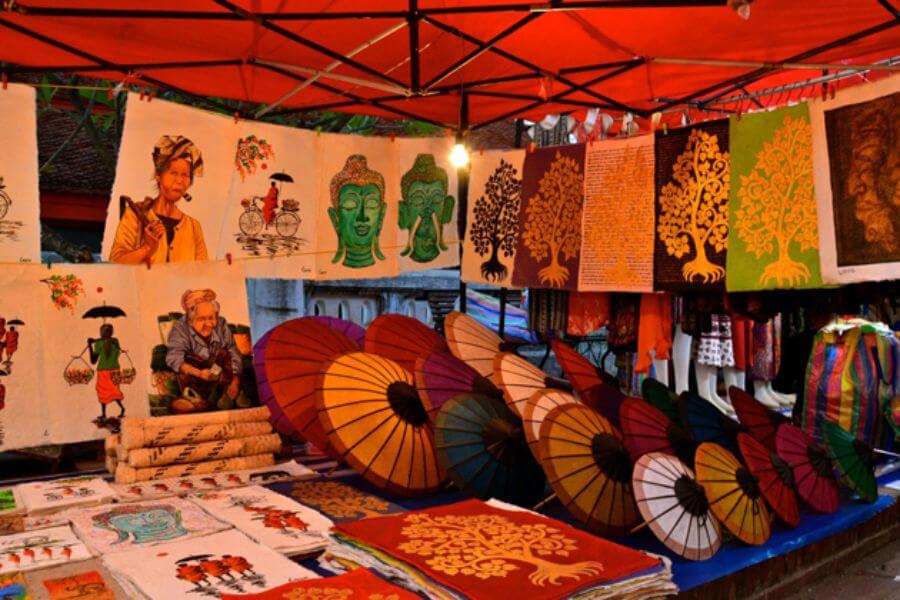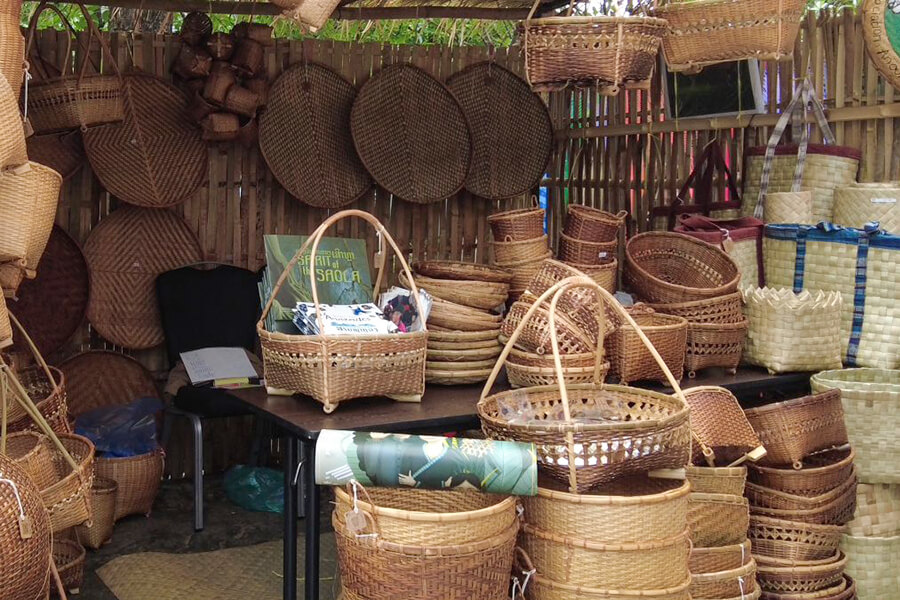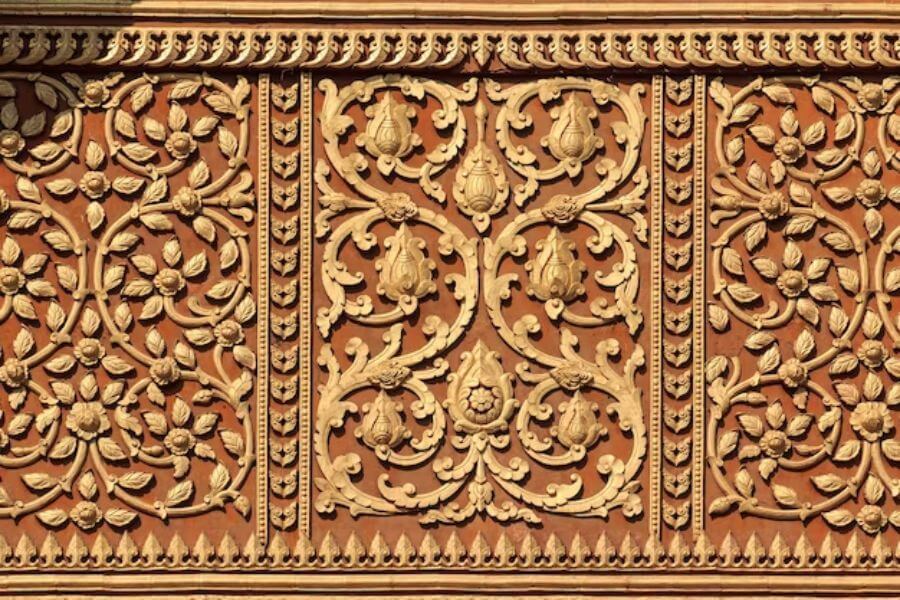Laos traditional handicrafts play an essential role in the preservation of this rich heritage culture country. From textiles to wood carvings, Lao artisans have been producing traditional handicrafts for centuries. Exploring the local handicraft scene is an excellent way for visitors to experience Lao culture and support local artisans
Laos Traditional Handicrafts
Laos traditional handicrafts encompass a wide range of traditional crafts, each with its unique history and cultural significance. Textiles are perhaps the most famous Laos handicraft, with silk being the most widely produced. Laos textiles are known for their intricate designs, bright colors, and the use of natural dyes. Other popular Laos handicrafts include wood carvings, pottery, and silverware.
Each handicraft has its history and is often associated with particular ethnic groups or regions of Laos. For example, Hmong people in northern Laos are known for their embroidery, while the Khmu people are famous for their basketry. Visitors can learn about these handicrafts by visiting local markets, museums, or workshops where they can meet artisans and see their craft-making process.
Exploring Laos Traditional Handicrafts: Meeting Lao Artisans
Meeting Laos artisans is an excellent way to learn about Laos traditional handicrafts and support local communities. Visitors can visit local villages or workshops to see artisans in action and purchase handmade goods directly from them. This direct interaction allows visitors to gain a deeper understanding of the handicraft-making process, the significance of each craft, and the artisans' lives.
One way to meet artisans is by visiting the Ock Pop Tok Living Crafts Centre in Luang Prabang. The center offers workshops, tours, and cultural performances, providing an excellent opportunity to meet Lao artisans and learn about Laos traditional handicrafts. Visitors should also be aware that bargaining is a common practice in Laos markets, and prices can be negotiated. However, visitors should be respectful and mindful of the value of the handicrafts and not bargain too hard, as this can be disrespectful to the artisans.
Exploring Laos Traditional Handicrafts: Textiles in Laos
Textiles are an important part of Laos culture and heritage, and Laos traditional handicrafts are still produced using ancient techniques. Silk and cotton are the most common materials used to make Lao textiles. The silk is locally produced and handwoven using a traditional loom. The cotton is often dyed with natural dyes and then handwoven into intricate patterns.
There are many different types of textiles produced in Laos, including phaa sin, a traditional Lao skirt worn by women, and phaa biang, a scarf worn by both men and women. These Laos traditional handicrafts are often adorned with intricate patterns and designs, such as elephants and flowers, and are highly prized by collectors and tourists
Exploring Laos Traditional Handicrafts: Wood Carvings in Laos
Wood carving is another traditional handicraft in Laos, with a long history and cultural significance. Laos wood carvings are typically made from teak, rosewood, or ebony and feature intricate designs inspired by nature, Buddhism, and mythology. Laos traditional handicrafts, such as wood carvings, are considered to be important cultural artifacts. One of the most famous types of Lao wood carving is the kinnari carving, which depicts a half-bird, half-human creature from Buddhist mythology. Kinnari carvings can be found in temples and royal palaces throughout Laos and are considered a symbol of good luck and prosperity.
Other popular Laos wood carvings include those of animals, such as elephants and water buffaloes, as well as furniture and household items, such as bowls and spoons. Visitors can watch local artisans create wood carvings in workshops and purchase handmade carvings directly from the artisans. In addition to their aesthetic appeal, Lao wood carvings also hold cultural significance. Many carvings are used in religious ceremonies and rituals, and are believed to have spiritual power and protective qualities.
Other Laos Traditional Handicrafts
Apart from textiles and wood carvings, Laos is also known for its other Laos traditional handicrafts, including pottery, basketry, jewelry, and metalwork. These handicrafts are created by skilled local artisans and are widely available in markets and shops throughout the country. Pottery in Laos is typically made using traditional methods and techniques, with clay sourced from local areas. The pots and other pieces are often fired in traditional kilns and decorated with intricate designs, coming in various shapes and sizes from small bowls to large vases.
Basketry is another ancient craft in Laos, where baskets are made from bamboo, rattan, and other materials, and used for a variety of purposes from carrying goods to storing items in homes. The weaving techniques used in basketry vary by region and many baskets are adorned with colorful patterns. Jewelry in Laos is typically made from metals such as silver and brass, with skilled artisans creating intricate designs inspired by traditional Lao motifs like the naga or the lotus flower. These pieces make unique and beautiful souvenirs and reflect the cultural heritage and craftsmanship of Laos traditional handicrafts.
Souvenirs from Laos Traditional Handicrafts
When bringing home handicrafts as souvenirs, it is important to be aware of customs and import regulations. Many countries have restrictions on the import of certain materials, such as wood or animal products. It is important to research these regulations before making a purchase. When shopping for handicrafts, it is also important to be respectful of local artisans and their work. Bargaining is a common practice in markets throughout Laos, but it is important to negotiate fairly and not to haggle too aggressively. Paying a fair price for a piece of handicraft is a way to support the local economy and ensure that artisans are paid fairly for their work.
Experiencing Laos traditional handicrafts is an important part of any trip to the country. From textiles and wood carvings to pottery and jewelry, there are many beautiful and unique pieces to be found. By shopping for handicrafts and supporting local artisans, travelers can help to preserve traditional crafts and support the local economy. So next time you're on a Laos tour, be sure to explore the markets and shops to discover some of the country's best handicrafts.







